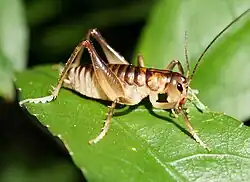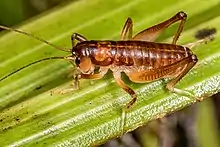Hemiandrus
Hemiandrus is a genus of wētā in the family Anostostomatidae. In New Zealand they are known as ground wētā due to their burrowing lifestyle.[1][2] Hemiandrus wētā are nocturnal,[3] and reside in these burrows during the day.[4] Ground wētā seal the entrance of their burrow during the day with a soil plug or door so that their burrow is concealed.[4] This genus was originally said to be distributed in Australia and New Zealand, however, with recent molecular genetic methods, this is under debate. Ground wētā adults are smaller than other types of wētā, with the unusual trait of having both long and short ovipositors, depending on the species. The name of this genus is said to come from this trait as hemi- mean half and -andrus means male, as the species where the female has a short ovipositor can sometimes be mistaken for a male. This genus has a diverse diet, depending on the species.
| Hemiandrus | |
|---|---|
 | |
| Hemiandrus pallitarsis | |
| Scientific classification | |
| Kingdom: | |
| Phylum: | |
| Class: | |
| Order: | |
| Suborder: | |
| Family: | |
| Genus: | Hemiandrus Ander, 1938 |
| Species | |
|
See text. | |
| Synonyms | |
|
Zealandosandrus Salmon, 1950 | |

Taxonomy
The genus Hemiandrus was originally described by Kjell Ander in 1938.[5] 10 undescribed species of this genus are said to be in Australia,[6] however molecular analyses show that the two lineages genetically represent two separate lineages, therefore their Australasian distribution is under debate.[7] Hemiandrus is however the most species rich genus of the New Zealand Anostostomatidae.[6]
Morphology
The genus Hemiandrus include the smallest wētā species, with adult individual body size no more than 7 millimetres,[6] and weighing less than a gram.[8] The largest Hemiandrus species has a body length of almost 30mm.[9] These wētā have no tympanum, and instead are able to detect sound through their cuticle, which is adaptive for their underground lifestyle.[2] Some species in this genus have unusually short ovipositors for Orthopterans, the species with this morphological trait exhibit maternal care,[4] which is uncommon as it occurs only in five families within the Orthoptera order.[10]
Diet
The diet of these wētā depends on the species, where H. maculifrons is carnivorous,[11] H. maia is omnivorous, eating fruit and invertebrates.[4][12] Other ground wētā species however have been shown to be mainly herbivorous, eating apricots and various grass species.[13]
Distribution
- Australia (Undescribed species)[14][15]
- New Zealand - This genus are found throughout the North and South Island, and even on some of the offshore islands of New Zealand.[6] (See distribution map http://wetageta.massey.ac.nz/Text%20files/groundweta.html). They are found in lowland forests, riverbeds, alpine herb fields, and suburban gardens.[4] If this genus also occurs in Australia (which there is debate about[7]), then this is the only non-endemic genus of wētā in New Zealand.[8]
Behaviour
Several Hemiandrus species have been recorded stridulating, despite lacking the tympanum 'ears' present in other wētā genera. The sounds produced are inaudible to humans and is detected through the cuticle.[2][16][17] Many of the 'short ovipositor' species have been found to exhibit maternal care with females laying eggs in their burrows and remaining with the eggs and even nymphs while they develop.[16][4][18]
Hemiandrus in New Zealand
There are approximately 14 undescribed New Zealand species of this genus,[4] with 19 described species.[6][19][9] These species of Hemiandrus are eaten by native species such as the wattle birds,[20] kiwi,[21] but also by introduced species such as mice,[22] stoats,[23] cats,[24] and hedgehogs.[25] Of the described species in this genus, half have a restricted range, but most are common and widespread, and are not thought to be endangered (as per the New Zealand Department of Conservation).[26]
Species
- Hemiandrus bilobatus Ander, 1938
- Hemiandrus brucei Taylor-Smith, Trewick & Morgan-Richards, 2016
- Hemiandrus celaeno Trewick, Taylor-Smith & Morgan-Richards 2020
- Hemiandrus electra Taylor-Smith, Morgan-Richards & Trewick, 2013
- Hemiandrus fiordensis (Salmon, 1950)
- Hemiandrus focalis (Hutton, 1897)
- Hemiandrus jacinda Trewick, 2021[9]
- Hemiandrus lanceolatus (Walker, 1869)
- Hemiandrus luna Taylor-Smith, Trewick & Morgan-Richards, 2016
- Hemiandrus maculifrons (Walker, 1869)
- Hemiandrus maia Taylor-Smith, Morgan-Richards & Trewick, 2013
- Hemiandrus merope Trewick, Taylor-Smith & Morgan-Richards 2020
- Hemiandrus nitaweta Jewell, 2007
- Hemiandrus nox Taylor-Smith, Trewick & Morgan-Richards, 2016
- Hemiandrus pallitarsis (Walker, 1869)
- Hemiandrus sterope Trewick, Taylor-Smith & Morgan-Richards 2020
- Hemiandrus subantarcticus (Salmon, 1950)
- Hemiandrus superba Jewell, 2007
- Hemiandrus taygete Trewick, Taylor-Smith & Morgan-Richards 2020
Possibly also:
- Hemiandrus monstrosus Salmon, 1950 (listed as valid in the Orthoptera Species File,[27] as a synonym by other secondary sources[5])
References
- Gwynne, D. T. (2014). "A secondary copulatory structure in a female insect: a clasp for a nuptial meal?". Naturwissenschaften. 89 (3): 125–127. doi:10.1007/s00114-002-0298-y. PMID 12046632. S2CID 28093747.
- Strauß, J.; Lomas, K.; Field, L. H. (2017). "The complex tibial organ of the New Zealand ground weta: sensory adaptations for vibrational signal detection". Scientific Reports. 7 (1): 2031. Bibcode:2017NatSR...7.2031S. doi:10.1038/s41598-017-02132-1. PMC 5435688. PMID 28515484.
- Chappell, E. M.; Trewick, S. A.; Morgan-Richards, M. (2012). "Shape and sound reveal genetic cohesion not speciation in the New Zealand orthopteran, Hemiandrus pallitarsis, despite high mitochondrial DNA divergence". Biological Journal of the Linnean Society. 105 (1): 169–186. doi:10.1111/j.1095-8312.2011.01777.x.
- Taylor Smith, B. L.; Morgan-Richards, M.; Trewick, S. A. (2013). "New Zealand ground wētā (Anostostomatidae: ): descriptions of two species with notes on their biology". New Zealand Journal of Zoology. 40 (4): 314–329. doi:10.1080/03014223.2013.804422.
- Johns, P. M. (1997). "The Gondwanaland Weta: Family Anostostomatidae (Formerly in Stenopelmatidae, Henicidae or Mimnermidae): Nomenclatural Problems, World Checklist, New Genera and Species". Journal of Orthoptera Research (6): 125–138. doi:10.2307/3503546. JSTOR 3503546.
- Taylor-Smith, B. L.; Trewick, S. A.; Morgan-Richards, M. (2016). "Three new ground wētā species and a redescription of". New Zealand Journal of Zoology. 43 (4): 363–383. doi:10.1080/03014223.2016.1205109. S2CID 88565199.
- Pratt, R. C; Morgan-Richards, M.; Trewick, S. A (2008). "Diversification of New Zealand weta (Orthoptera: Ensifera: Anostostomatidae) and their relationships in Australasia". Philosophical Transactions of the Royal Society B: Biological Sciences. 363 (1508): 3427–3437. doi:10.1098/rstb.2008.0112. PMC 2607373. PMID 18782727.
- Chappell, E. M.; Webb, D. S.; Tonkin, J. D. (2014). "Notes on sexual size dimorphism, sex ratio and movements of adult ground weta (Walker) (Orthoptera: Anostostomatidae)". New Zealand Entomologist. 37 (2): 83–92. doi:10.1080/00779962.2013.856377. S2CID 4814697.
- Trewick, Steven A. (2021-03-12). "A new species of large Hemiandrus ground wētā (Orthoptera: Anostostomatidae) from North Island, New Zealand". Zootaxa. 4942 (2): 207–218. doi:10.11646/ZOOTAXA.4942.2.4. PMID 33757066.
- Gwynne, D. T. (1995). "Phylogeny of the Ensifera (Orthoptera): A Hypothesis Supporting Multiple Origins of Acoustical Signalling, Complex Spermatophores and Maternal Care in Crickets, Katydids, and Weta". Journal of Orthoptera Research (4): 203–218. doi:10.2307/3503478. JSTOR 3503478.
- Cary, P. R. L. (1983). "Diet of the ground weta (Orthoptera: Stenopelmatidae)". New Zealand Journal of Zoology. 10 (3): 295–297. doi:10.1080/03014223.1983.10423918.
- Morgan-Richards, M (2008). "When is it coevolution? The case of ground wētā and fleshy fruits in New Zealand". New Zealand Journal of Ecology. Retrieved 2018-10-17.
- Basri, W. M. (1978). The biology and economic impact of the weta, Hemiandrus sp. (Orthoptera : Stenopelmatidae) in an apricot orchard, Horotane Valley (Thesis). Christchurch, New Zealand: Lincoln College, University of Canterbury. hdl:10182/3201.
- Johns, P.M. 1997: The Gondwanaland weta: family Anostostomatidae (formerly in Stenopelmatidae, Henicidae or Mimnermidae): nomenclatural problems, world checklist, new genera and species. Journal of Orthoptera research, (6): 125-138.
- Monteith, G.B.; Field, L.H. 2001: Australian king crickets: distribution, habitats and biology (Orthoptera: Anostostomatidae). Pp. 79-94 in Field, L.H. (ed.) The biology of wetas, king crickets and their allies. CABI publishing.
- Frans, Van Wyngaarden (1995). "The ecology of the Tekapo ground wētā (Hemiandrus new sp., Orthoptera: Anostostomatidae) and recommendations for the conservation of a threatened close relative". University of Canterbury Research Repository. doi:10.26021/6568.
- "Meet Bruce, he's a musician". New Zealand Geographic. Retrieved 2023-05-02.
- Gwynne, Darryl T. (2004). "Reproductive Behavior of Ground Weta (Orthoptera: Anostostomatidae): Drumming Behavior, Nuptial Feeding, Post-copulatory Guarding and Maternal Care". Journal of the Kansas Entomological Society. 77 (4): 414–428. doi:10.2317/E-34.1. ISSN 0022-8567.
- Trewick, Steven A.; Taylor-Smith, Briar; Morgan-Richards, Mary (2020). "Ecology and systematics of the wine wētā and allied species, with description of four new Hemiandrus species". New Zealand Journal of Zoology. 48: 47–80. doi:10.1080/03014223.2020.1790396. ISSN 0301-4223.
- Pierre, J. P. (2000). "Foraging behaviour and diet of a reintroduced population of the South Island Saddleback (Philesturnus carunculatus carunculatus)" (PDF). Notornis. 47: 7–12.
- Colbourne, R.; Baird, K.; Jolly, J. (1990). "Relationship between invertebrates eaten by little spotted kiwi, , and their availability on Kapiti Island, New Zealand". New Zealand Journal of Zoology. 17 (4): 533–542. doi:10.1080/03014223.1990.10422951.
- Wilson, D. J.; Lee, W. G. (2010). "Primary and secondary resource pulses in an alpine ecosystem: snow tussock grass ( spp.) flowering and house mouse ( ) populations in New Zealand". Wildlife Research. 37 (2): 89. doi:10.1071/WR09118.
- Smith, D. H. V.; Jamieson, I. G.; Peach, R. M. E. (2005). "Importance of ground weta (Hemiandrus spp.) in stoat (Mustela erminea) diet in small montane valleys and alpine grasslands". New Zealand Journal of Ecology. 29 (2): 207–214. JSTOR 24058176.
- Pascoe, Amelia (1995). "The effects of vegetation removal on rabbits (Oryctolagus cuniculus) and small mammalian predators in braided riverbeds of the Mackenzie Basin" (PDF). University of Otago.
- Jones, C.; Moss, K.; Sanders, M. (2005). "Diet of hedgehogs (Erinaceus europaeus) in the upper Waitaki Basin, New Zealand: Implications for conservation". New Zealand Journal of Ecology. 29 (1): 29–35. JSTOR 24056190.
- Johns, P. M. (2001). Distribution and conservation status of ground weta, Hemiandrus species (Orthoptera: Anastostomatidae) (PDF). Wellington, New Zealand: Department of Conservation. Retrieved 12 June 2018.
- "Species Hemiandrus monstrosus Salmon, 1950: Orthoptera Species File".